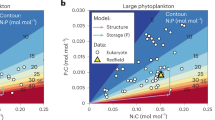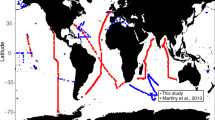Abstract
The ratio of carbon (C) to phosphorus (P) in marine phytoplankton is thought to be constant throughout the worlds’ oceans. Known as the Redfield ratio1, this relationship describes the links between carbon and phosphorus cycling and marine ecosystems2,3,4. However, variations in the stoichiometry of phytoplankton have recently been identified, in particular strong latitudinal variability5. Here we assess the impact of this variability in the C:P ratio of biomass on the C:P ratio of organic matter that is exported to the deep ocean using a biogeochemical inverse-model based on a data-constrained ocean circulation model6,7 and a global database8,9 of dissolved inorganic carbon and phosphate measurements. We identify global patterns of variability in the C:P ratios of exported organic matter, with higher values in the nutrient-depleted subtropical gyres, where organic matter export is relatively low, and lower ratios in nutrient-rich upwelling zones and high-latitude regions, where organic matter export is high. This suggests that total carbon export is relatively constant throughout the oceans, in agreement with recent estimates of carbon fluxes10. We conclude that the latitudinal patterns of C:P in exported organic matter are consistent with the large-scale stoichiometric variations in phytoplankton C:P. We suggest that a future expansion of nutrient-depleted waters could result in a shift to more efficient C export that compensates for the expected decline in productivity.
This is a preview of subscription content, access via your institution
Access options
Subscribe to this journal
Receive 12 print issues and online access
$259.00 per year
only $21.58 per issue
Buy this article
- Purchase on Springer Link
- Instant access to full article PDF
Prices may be subject to local taxes which are calculated during checkout




Similar content being viewed by others
References
Redfield, A., Ketchum, B. H. & Richards, F. A. in The Sea Vol. 2 (ed Hill, M. N.) 26–27 (Interscience, 1963).
Ito, T. & Follows, M. J. Preformed phosphate, soft tissue pump and atmospheric CO2 . J. Mar. Res. 63, 813–839 (2005).
Moore, J. K., Lindsay, K., Doney, S. C., Long, M. C. & Misumi, K. Marine ecosystem dynamics and biogeochemical cycling in the Community Earth System Model CESM1(BGC): Comparison of the 1990s with the 2090s under the RCP4.5 and RCP8.5 scenarios. J. Clim. 26, 929109312 (2013).
Bopp, L. et al. Multiple stressors of ocean ecosystems in the 21st century: Projections with CMIP5 models. Biogeosciences 10, 6225–6245 (2013).
Martiny, A. C. et al. Strong latitudinal patterns in the elemental ratios of marine plankton and organic matter. Nature Geosci. 6, 279–283 (2013).
Primeau, F. W., Holzer, M. & DeVries, T. Southern ocean nutrient trapping and the efficiency of the biological pump. J. Geophys. Res. 118, 2547–2564 (2013).
DeVries, T. & Primeau, F. Dynamically- and observationally-constrained estimates of water-mass distributions and ages in the global ocean. J. Phys. Oceanogr. 41, 2381–2401 (2011).
Key, R. M. et al. A global ocean carbon climatology: Results from Global Data Analysis Project (GLODAP). Glob. Biogeochem. Cycles 18 (2004).
Garcia, H. E. et al. World Ocean Atlas 2009. in NOAA Atlas NESDIS 71 Vol. 4 (ed Levitus, S.) 398 (US Government Printing Office, 2010).
Emerson, S. Annual net community production and the biological carbon flux in the ocean. Glob. Biogeochem. Cycles 28, 14–28 (2014).
Sarmiento, J. & Gruber, N. Ocean Biogeochemical Dynamics 503 (Princeton Univ. Press, 2006).
Takahashi, T., Broecker, W. & Langer, S. Redfield ratio based on chemical data from isopycnal surfaces. J. Geophys. Res. 90, 6907–6924 (1985).
Anderson, L. A. & Sarmiento, J. L. Redfield ratios of remineralization determined by nutrient data analysis. Glob. Biogeochem. Cycles 8, 65–80 (1994).
Li, Y-H. & Peng, T-H. Latitudinal change of remineralization ratios in the oceans and its implication for nutrient cycles. Glob. Biogeochem. Cycles 16, 1130 (2002).
Schneider, B., Karstensen, J., Oschlies, A. & Schlitzer, R. Model-based evaluation of methods to determine C:N and N:P regeneration ratios from dissolved nutrients. Glob. Biogeochem. Cycles 19, GB2009 (2005).
Gebbie, G. & Huybers, P. ‘How is the ocean filled?’. Geophys. Res. Lett. 38, L06604 (2011).
Martiny, A. C., Vrugt, J. A., Primeau, F. W. & Lomas, M. W. Regional variation in the particulate organic carbon to nitrogen ratio in the surface ocean. Glob. Biogeochem. Cycles 27, 723–731 (2013).
Deutsch, C. & Weber, T. Nutrient ratios as a tracer and driver of ocean biogeochemistry. Annu. Rev. Mar. Sci. 4, 113–141 (2012).
Wu, J. F., Sunda, W., Boyle, E. A. & Karl, D. M. Phosphate depletion in the western North Atlantic Ocean. Science 239, 759–762 (2000).
Lomas, M. W. et al. Sargasso Sea phosphorus biogeochemistry: An important role for dissolved organic phosphorus (DOP). Biogeosciences 7, 695–710 (2010).
Sohm, J. A., Webb, E. A. & Capone, D. G. Emerging patterns of marine nitrogen fixation. Nature Rev. Microbiol. 9, 499–508 (2011).
Luo, et al. Database of diazotrophs in global ocean: Abundance, biomass and nitrogen fixation rates. Earth Syst. Sci. Data 4, 47–73 (2012).
Moore, J. K. & Doney, S. C. Iron availability limits the ocean nitrogen inventory stabilizing feedbacks between marine denitrification and nitrogen fixation. Glob. Biogeochem. Cycles 21, GB2001 (2007).
Guilderson, T. P., McCarthy, M. D., Dunbar, R. B., Englebrecht, A. & Roark, E. B. Late Holocene variations in Pacific surface circulation and biogeochemistry inferred from proteinaceous deep-sea corals. Biogeosci. Discuss. 10, 3925–3949 (2013).
Laws, E. A., D’Sa, E. & Naik, B. Simple equations to estimate ratios of new or export production to total production from satellite derived estimates of sea surface temperature and primary production. Limnol. Oceanogr. Methods 9, 593–601 (2011).
Westberry, T. K., Williams, P. J. le B. & Behrenfeld, M. J. Global net community production and the putative net heterotrophy of the oligotrophic oceans. Glob. Biogeochem. Cycles 22, GB4019 (2012).
DeVries, T., Primeau, F. & Deutsch, C. The sequestration efficiency of the biological pump. Geophys. Res. Lett. 39, L13601 (2012).
Steinacher, M. Projected 21st century decrease in marine productivity: A multi-model analysis. Biogeosciences 7, 979–1005 (2010).
Westberry, T., Behrenfeld, M. J., Siegel, D. A. & Boss, E. Carbon-based primary productivity modeling with vertically resolved photoacclimation. Glob. Biogeochem. Cycles 26, GB4019 (2008).
Kwon, E. Y. & Primeau, F. Optimization and sensitivity of a global biogeochemistry ocean model using combined in situ DIC, alkalinity, and phosphate data. J. Geophys. Res. 113, C08011 (2008).
Acknowledgements
This work was supported by grant ER65358 from the US Department of Energy Office of Biological and Environmental Research to F.W.P. and J.K.M. A.C.M. and M.W.L. acknowledge support from NSF Dimensions of Biodiversity program and F.W.P. also acknowledges support from the National Science Foundation grant OCE-1131768.
Author information
Authors and Affiliations
Contributions
Y-C.T., F.W.P. and A.C.M. initiated this study. Y-C.T. and F.W.P. formulated the inverse problem and carried out the model inversions with advice from A.C.M. and J.K.M. M.W.L. provided the BATS sediment trap data. Y-C.T. and F.W.P. wrote the paper with input from A.C.M., J.K.M. and M.W.L.
Corresponding author
Ethics declarations
Competing interests
The authors declare no competing financial interests.
Supplementary information
Supplementary Information
Supplementary Information (PDF 7283 kb)
Rights and permissions
About this article
Cite this article
Teng, YC., Primeau, F., Moore, J. et al. Global-scale variations of the ratios of carbon to phosphorus in exported marine organic matter. Nature Geosci 7, 895–898 (2014). https://doi.org/10.1038/ngeo2303
Received:
Accepted:
Published:
Issue Date:
DOI: https://doi.org/10.1038/ngeo2303
This article is cited by
-
Spatial Distribution and Seasonal Variation of Hypoxic Zone in the Eastern Equatorial Indian Ocean
Journal of Ocean University of China (2023)
-
Particulate Organic Carbon (POC) Estimation and Algorithm Development in Northeast Arabian Sea Coastal Water
Thalassas: An International Journal of Marine Sciences (2023)
-
Global patterns and predictors of C:N:P in marine ecosystems
Communications Earth & Environment (2022)
-
Global patterns in marine organic matter stoichiometry driven by phytoplankton ecophysiology
Nature Geoscience (2022)
-
Declining metal availability in the Mesozoic seawater reflected in phytoplankton succession
Nature Geoscience (2022)



